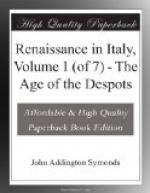In the fourteenth and the first half of the fifteenth centuries the authority of the Popes, both as Heads of the Church and as temporal rulers, had been impaired by exile in France and by ruinous schisms. A new era began with the election of Nicholas V. in 1447, and ended during the pontificate of Clement VII. with the sack of Rome in 1527. Through the whole of this period the Popes acted more as monarchs than as pontiffs, and the secularization of the See of Rome was earned to its utmost limits. The contrast between the sacerdotal pretensions and the personal immorality of the Popes was glaring; nor had the chiefs of the Church yet learned to regard the liberalism of the Renaissance with suspicion. About the middle of the sixteenth century the Papal States had become a recognized kingdom; while the Popes of this later epoch were endeavoring by means of the inquisition and the educational orders to check the free spirit of Italy.
The history of Italy has at all times been closely bound up with that of the Papacy; but at no period has this been more the case than during these eighty years of Papal worldliness, ambition, depotism, and profligacy, which are also marked by the irruption of the European nations into Italy and by the secession of the Teutonic races from the Latin Church. In this short space of time a succession of Popes filled the Holy Chair with such dramatic propriety—displaying a pride so regal, a cynicism so unblushing, so selfish a cupidity, and a policy so suicidal as to favor the belief that they had been placed there in the providence of God to warn the world against Babylon. At the same time the history of the Papal Court reveals with peculiar vividness the contradictions of Renaissance morality and manners. We find in the Popes of this period what has been already noticed in the despots—learning, the patronage of of the arts, the passion for magnificence, and the refinements of polite culture, alternating and not unfrequently combined with barbarous ferocity of temper and with savage and coarse tastes. On the one side we observe a Pagan dissoluteness which would have scandalized the parasites of Commodus and Nero; on the other, a seeming zeal for dogma worthy of S. Dominic. The Vicar of Christ is at one time worshiped as a god by princes seeking absolution for sins or liberation from burdensome engagements; at another he is trampled under foot, in his capacity of sovereign, by the same potentates. Undisguised sensuality; fraud cynical and unabashed; policy marching to its end by murders, treasons, interdicts, and imprisonments; the open sale of spiritual privileges; commercial traffic in ecclesiastical emoluments; hypocrisy and cruelty studied as fine arts; theft and perjury reduced to system—these are the ordinary scandals which beset the Papacy. Yet the Pope is still a holy being. His foot is kissed by thousands. His curse and blessing carry death and life. He rises from the bed of harlots to unlock or bolt




